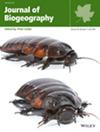Environmental and Evolutionary Forces Shaping Penguin Geographic Limits
Abstract
Aim
Penguins are seabirds exclusively found in the Southern Hemisphere, with their existence dating back to the late Cretaceous. Despite their exceptional dispersal capabilities, which allow them to inhabit a wide range of environments—from polar regions to temperate zones, and even near the Equator—penguins are absent in the Northern Hemisphere. This study aims to determine whether phylogenetic niche conservatism could explain why penguins are restricted to the Southern Hemisphere.
Location
Global.
Methods
We built a robust database using presence and absence data for penguins and based the variables on Soberón and Peterson's concept of niche, incorporating temperature, marine productivity and latitude and longitude maps to represent Fundamental Niche, Interspecific interactions, and Accessible Area, respectively. We employed multiple modelling algorithms and conducted a phylogenetic niche conservation test. Additionally, we performed an independent analysis using unsupervised classification to identify climatically similar regions and clusters.
Results
We found the highest suitability frequency in the Southern Hemisphere, although suitable locations also exist in the Northern Hemisphere. The overall rate of phylogenetic niche conservation was strong. Our analysis of climatic similarities between the two hemispheres revealed a lack of correspondence.
Mains Conclusions
According to results, the Southern Hemisphere is the most suitable environment for penguins. The relationship between cold ocean currents and these seabirds extends beyond the historical dispersal pathways, suggesting a link to the maintenance of living species. The strong phylogenetic niche conservation value that was identified may partially explain why the majority of penguin niches are restricted to regions with milder temperatures, as extinct lineages thrived in such climates. Furthermore, phylogenetic niche conservatism appears to be a significant barrier, confining penguins to the Southern Hemisphere.


 求助内容:
求助内容: 应助结果提醒方式:
应助结果提醒方式:


